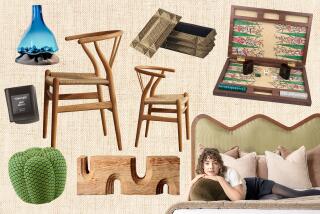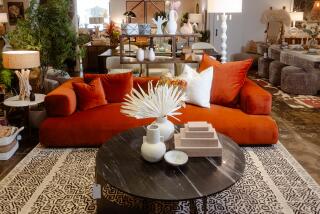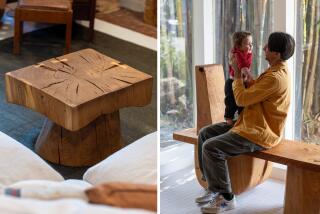FURNISHINGS : Architects Fashion Plywood Into Affordable Art
An enduring modernist dream is to create great-looking furniture that is affordable. Elusive but not impossible.
Recent independent efforts by a couple of architects depend on plywood and a router, which can cut plywood into intricate shapes with the same apparent ease as scissors to paper. Silvio Russo, a New Yorker born and trained in Italy, designs storage units, room dividers and tables. Gregg Fleishman of Los Angeles cuts out Lumbarest chairs.
Plywood, workhorse of the furniture industry, is made by gluing and pressing thin sheets of wood together, usually with the grain on one sheet at a right angle to the next. Its telltale edges generally are covered with veneer. In Russoâs pieces, those edges are raw.
Russoâs fanciful, colorful laminate-surfaced storage pieces, room dividers and tables are shipped flat. They are put together much like three-dimensional jigsaw puzzles. Little or no hardware is required. The precise shapes are made by a computer-controlled router programmed to make complicated cuts automatically.
A circular etagere consists of two interlocking vertical panels and six disks that form the shelves.
Small occasional tables can be taken apart when not in use. The pieces then can be hung on the wall as sculpture or strung together to form longer tables.
Quarter-circle bookcases can be placed together to form a half or three-quarter circle, thus creating a room within a room. Or they can be attached in reverse order like an undulating wave.
Perforated screens look like sheets of paper cut in geometric patterns.
The playful quality of the pieces isnât surprising. Russo says his inspiration comes from that popular childhood activity, cutting and folding paper.
âThe furniture is in happy colors,â he adds. âThe pieces are characters you bring home, like a friend.â
The furniture, the Dipiu Collection, was named best new design at the most recent International Contemporary Furniture Fair in New York. It is sold at Palazzetti stores in Dallas, New York, Philadelphia and Toronto. Prices range from $250 for a side table to $2,990 for a curved bookcase that measures 8 feet by 6 1/2 feet.
The more materials and steps in the manufacture of furniture, the more expensive it is to build, says Fleishman, whose plywood chairs require only one main process--routing. Thereâs no hardware and minimal sawing and sanding.
The chairs get their shape and their bounce from the numerous cuts he makes with a hand router. The wood itself becomes a flat, spring-like surface that accommodates the body and rocks lightly when someone sits down.
Fleishmanâs father, a chiropractor, put a chair in his office and asked his patients to submit names for it. Lumbarest was the winner.
The chairs are part of a series that Fleishman has been working on since 1984. Most of the pieces are made from a single sheet of plywood and assembled by bending and interlocking the parts. The Museum of Modern Art in New York recently bought one to add to its permanent collection. Others are at the Art Institute of Chicago and the Yale University Art Gallery.
The chairs are available through art galleries, though Fleishman also plans a studio and retail space in Culver City. Prices for the Lumbarest range from about $850 to $1,500, depending on finish and design.
Both men want to reduce waste and keep costs down.
âThe goal is to simplify the making of furniture and other objects by eliminating complexity,â Fleishman says. âWe live in a culture with limited resources, and we have to start learning how to get more from less.â


